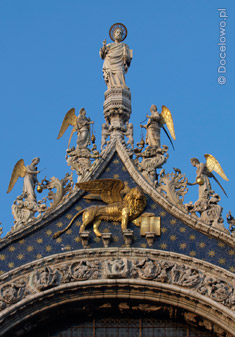St Mark’s Basilica was built at St. Mark’s Square. Venetians wanted by this way dignified burial relics of the patron of the city.
As early as 828 Venetian merchants stole his remains from Alexandria and brought to the lagoon. According to legend, its here rested St. Mark, what the angel had told him. It is no wonder that the evangelist was recognized as the patron of Venice, and his symbol – a winged lion holding a book with the words “Pax tibi, Marce evangelista meus” was placed in the coat of arms of the Republic.
The first church was founded by Doge Angelo Partycipazio in 832. Unfortunately, in 976 it burnt down. The same happened with the nearby Doge’s Palace. To the reconstruction began only in the years 1063-1094. Since then, both the exterior and solid of basilica was rebuilt many times. During the reconstruction it was modeled on Constantinople St. Apostles church. For this reason, the temple erected on a Greek cross. Characteristic are also domes, arranged over four aisles located in the arms of the cross and over the field at the intersection of the aisles. This refers to the construction of Islamic architecture, as evidenced by the fact that similar solutions applied in the construction of a Umar mosque in Jerusalem and Fatimid dynasty mausoleum in Cairo.
Subsequent years brought another rebuilding of the temple. Was added to it, inter alia, narthex surrounding the input arm. In addition, each Venice vessel was obliged to imported gifts, decorating then basilica. The result is a building diverse, but also very interesting in terms of style.
Its distinguishing feature is also a 52-meter facade with five portals topped with semicircular tympanums and decorated with colorful mosaics. Added to this is a very colorful mosaic from 1260 and horizontal gallery, available for tourists. Its central location is a copy of a four horses from the quadriga. The original is in the Museo Marciano. The idea to bring the sculpture from the Constantinople Hippodrome came up with the Doge Enrico Dandolo. The sculpture is preserved in very good condition. Its construction dates back to the period between the IV century BC and I century BC.
The interior of the church is a bit less diverse, but looks equally impressive. Visitors conspicuous mainly marble columns topped with gilded Corinthian heads. In addition, the walls and pillars were covered with a slab of marble, and on the floor, domes and vault Constantinople artists drew up a beautiful mosaic. Later they were joined by the artists of the Venetian. Total mosaic covered with approx. 4,000 m2.
In the Basilica, just behind the main altar, is extremely valuable monument of art jewelry, dating from the reign of the Byzantine Empire. This is the Golden Altar (Pala d’Oro), the first part (plaque with dimensions 3,40×1,40 m) was made in 976 in Constantinople. Over time, added more plaques. Each of these contains, among others, 1300 pearls, 300 emeralds, 300 sapphires, 400 grenades and 15 rubies.
Characteristic feature is also Capitello del Crocifisso or crucifix brought from Constantinople in the early thirteenth century. It covers the ciborium supported by six marble columns topped by Byzantine, gilded heads. At the top of the canopy placed agate with 31 cm diameter.
In addition to the temple items discussed briefly, is worth to mention coming from the tenth century icon of the Madonna Nikopea, two pulpits of the fourteenth century and fourteenth century baptistery.

